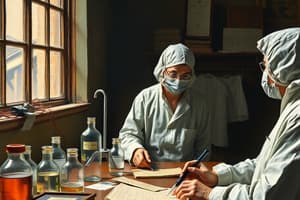Podcast
Questions and Answers
What is the purpose of a lab coat?
What is the purpose of a lab coat?
- To hold test tubes
- To protect eyes from splashes
- To protect clothing and skin from spills (correct)
- To measure liquid volumes
Which of these items is used for working with volatile chemicals?
Which of these items is used for working with volatile chemicals?
- Graduated Cylinder
- Fume Hood (correct)
- Test Tube Holder
- Fire Extinguisher
The unit of measurement for liquid volumes is _____
The unit of measurement for liquid volumes is _____
milliliters
What does the Biuret test identify?
What does the Biuret test identify?
What is the main purpose of an emergency shower and eyewash station?
What is the main purpose of an emergency shower and eyewash station?
What are electrolytes?
What are electrolytes?
Grams are used for measuring liquid volumes.
Grams are used for measuring liquid volumes.
Match the tests with what they identify:
Match the tests with what they identify:
What does the toothpick method with iodine test for?
What does the toothpick method with iodine test for?
What is the formula for calculating total magnification?
What is the formula for calculating total magnification?
What is a positively charged atom called?
What is a positively charged atom called?
What is the main purpose of observing onion root tips?
What is the main purpose of observing onion root tips?
What do lipids turn when tested with Sudan IV?
What do lipids turn when tested with Sudan IV?
Flashcards are hidden until you start studying
Study Notes
Safety Items in the Lab
- Lab Coat: Protects clothing and skin from spills.
- Goggles: Shields eyes from chemical splashes and broken glass.
- Gloves: Safeguard hands against harmful substances.
- Fume Hood: Contains fumes when working with volatile chemicals.
- Fire Extinguisher: Essential for emergency fire situations.
- Emergency Shower/Eyewash Station: Used for rinsing chemicals from body or eyes.
- First Aid Kit: Contains supplies for treating minor injuries.
Measurement Units
- Milliliters (mL): Measures liquid volumes using graduated cylinders, pipettes, or beakers.
- Grams (g): Measures mass, typically with an electronic balance.
- Microliters (μL): Measures very small volumes, often with micropipettes.
- Precision: Ensures accuracy through appropriate measuring devices.
Lab Hardware
- Test Tubes: Glass containers for holding or mixing substances.
- Test Tube Holder: Used to grasp test tubes, particularly when hot.
- Forceps: Tweezers for handling small objects.
- Beakers: Containers for holding, mixing, or heating liquids.
- Graduated Cylinders: More accurate than beakers for measuring liquid volumes.
- Pipettes: Tools for measuring and transferring small liquid amounts.
DI Water (Deionized Water)
- Definition: Purified water with removed ions, salts, and minerals.
- Uses: Prevents contamination and serves as a solvent in experiments.
Independent vs. Dependent Variables
- Independent Variable: Changed or controlled in an experiment (e.g., type of fertilizer).
- Dependent Variable: Observed or measured in response (e.g., plant growth).
- Identification: Independent is what is changed; Dependent is what is measured.
Tests for Macromolecules
- Biuret Test: Identifies proteins; turns purple in their presence.
- Benedict’s Solution: Tests for reducing sugars; changes from blue to red/orange when heated.
- Iodine Test: Detects starch; turns blue-black if present.
- Sudan IV: Tests for lipids; turns red/orange in the presence of lipids.
Toothpick Method with Powder
- Purpose: Identifies starch in a sample.
- Procedure: Iodine-dipped toothpick tests powder; blue-black indicates starch's presence.
Electrolyte Tester
- Electrolytes: Substances that conduct electricity in solution (salts, acids, bases).
- Tester Use: Measures solution conductivity; high indicates many electrolytes, low indicates few.
Compound Microscope
- Components: Stage (where slide is placed), Light Source (illuminates slide), Objective Lenses (various magnifications), Ocular Lenses (usually 10x), Coarse/Fine Adjustment Knobs (focus image).
- Viewing: Used to observe small organisms and structures like cells.
- Total Magnification: Ocular magnification multiplied by objective magnification (e.g., 10x ocular with 40x objective equals 400x total magnification).
Charged Atoms
- Cations: Positively charged atoms that have lost electrons (e.g., Sodium ion Na+).
- Anions: Negatively charged atoms that have gained electrons (e.g., Chloride ion Cl-).
Onion Root Tip
- Purpose: Observes stages of cell division (mitosis).
- Preparation: Root tips stained and viewed microscopically to identify phases: interphase, prophase, metaphase, anaphase, and telophase.
Identification of Macromolecules
- Proteins: Composed of amino acids; tested by Biuret solution (turns purple).
- Carbohydrates: Includes sugars (monosaccharides) and starches (polysaccharides); tested with Benedict’s (for sugars) and Iodine (for starches).
- Lipids: Fats and oils; tested with Sudan IV (turns red).
- Nucleic Acids: DNA and RNA; identification typically not common in basic labs.
Studying That Suits You
Use AI to generate personalized quizzes and flashcards to suit your learning preferences.




